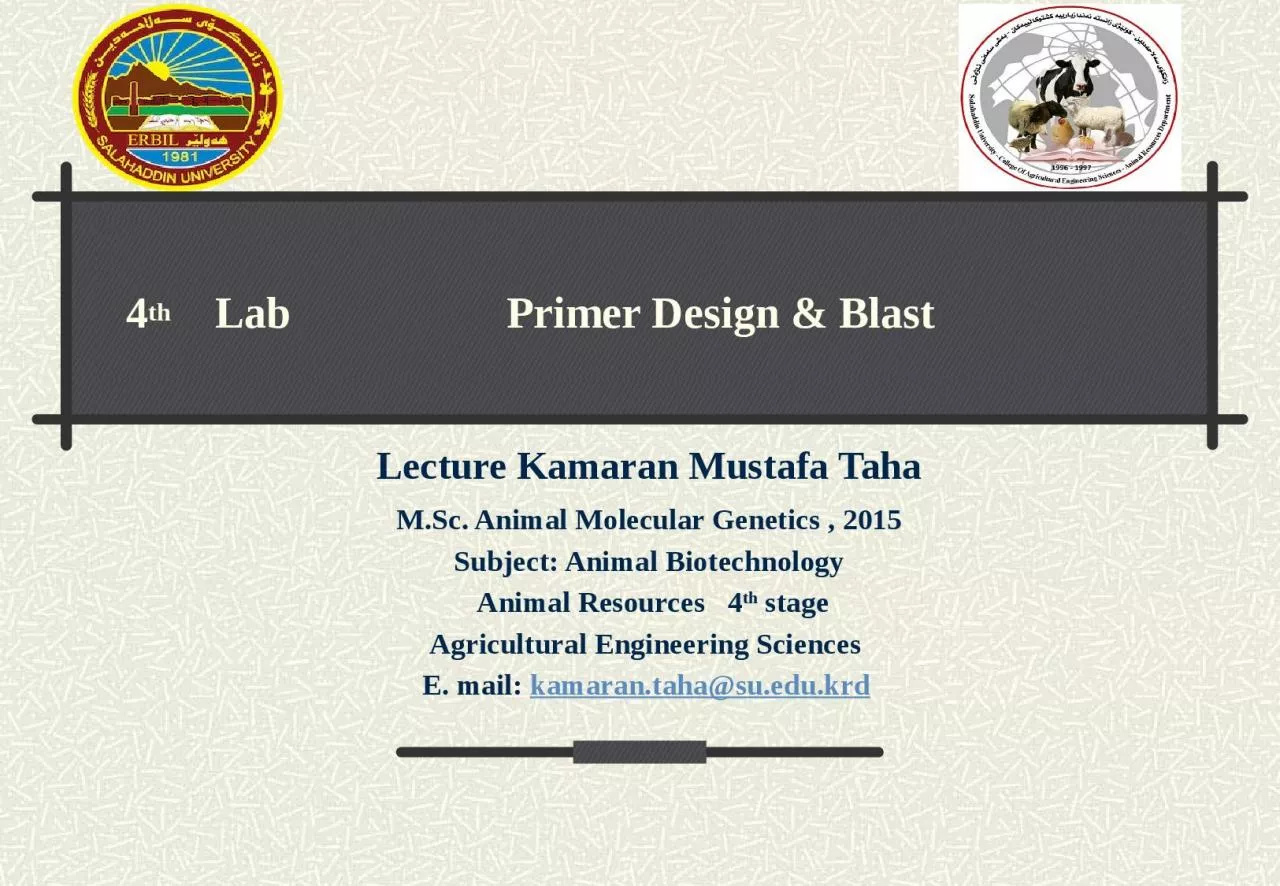

Primer Design amp Blast Lecture Kamaran Mustafa Taha MSc Animal Molecular Genetics 2015 Subject Animal Biotechnology Animal Resources 4 th stage Agricultural Engineering Sciences ID: 1044919
Download Presentation The PPT/PDF document "4 th Lab" is the property of its rightful owner. Permission is granted to download and print the materials on this web site for personal, non-commercial use only, and to display it on your personal computer provided you do not modify the materials and that you retain all copyright notices contained in the materials. By downloading content from our website, you accept the terms of this agreement.
1. 4th Lab Primer Design & Blast Lecture Kamaran Mustafa TahaM.Sc. Animal Molecular Genetics , 2015Subject: Animal Biotechnology Animal Resources 4th stageAgricultural Engineering Sciences E. mail: kamaran.taha@su.edu.krd
2. Introduction: A primer: is a strand of short nucleic acid sequences that serves as a starting point for DNA synthesis. It is required for DNA replication because the enzymes that catalyze this process, DNA polymerases, can only add new nucleotides to an existing strand of DNA. The polymerase starts replication at the 3'-end of the primer, and copies the opposite strand.For a successful PCR requires efficient and specific amplification oligonucleotides – DNA primers.2
3.
4. . Uniqueness: ensure correct priming site (There should be one and only one target site in the template DNA where the primer binds, which means the primer sequence should be unique in the template DNA, avoiding the possibility of mis-hybridization to a similar sequence nearby).Length: 18-28 bases. (The longer the primer, the more chance that it is unique; and the longer the primer, the higher melting/annealing temperature – specificity) 4Good Primer’s Characteristic:
5. 5 Base composition: average (G+C) content around 40-60%; avoid long (A+T) and (G+C) rich region if possible (Avoid long (A+T) and (G+C) rich region if possible. Repeats: A repeat is a dinucleotide occurring many times consecutively and should be avoided because they can mis-prime. A maximum number of dinucleotide repeats acceptable in an oligo is 4 dinucleotides). Template DNA 5’..TCGATATATATGCATG…GATGCCGGCGCGCTGTACACAA..3’
6. Optimize base pairing: The presence of G or C bases within the last five bases from the 3' end of primers (GC clamp) to enhance annealing of the end which will be extended due to the stronger bonding of G and C bases. More than 3 G's or C's should be avoided in the last 5 bases at the 3' end of the primer – mis-priming 5‘-CCGATATGCCAGCTATCTGT-3’6
7. Melting Temperature Tm: The temperature at which 50% of the primer molecules are bound to their corresponding target sequence. Tm is characteristics of the DNA/Base composition; Higher G+C content DNA, has a higher Tm due to more Hydrogen-bonds. (3 vs. only 2 in A::T). in general (52 -65 °C).
8. Assure that F/R primers have annealing temperature within 2 – 3 °C of each other Annealing Temperature, T, anneal – the temperature at which primers anneal to the template DNA. 8
9. . Minimize internal secondary structure: hairpins and dimers should be avoided (minimize self-complementarity and 3’end self-complementarity). If primers can anneal to themselves or anneal to each other (primer dimer) rather than anneal to the template.9
10.
11. 11 Questions are welcomed?